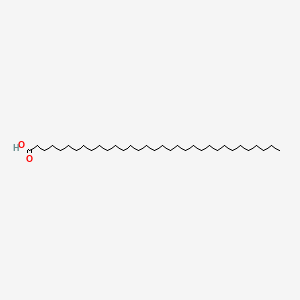| MeSH term | MeSH ID | Detail |
|---|---|---|
| Diabetes Mellitus, Type 2 | D003924 | 87 associated lipids |
| Hypercholesterolemia | D006937 | 91 associated lipids |
| Body Weight | D001835 | 333 associated lipids |
tritriacontanoic acid
tritriacontanoic acid is a lipid of Fatty Acyls (FA) class. Tritriacontanoic acid is associated with abnormalities such as hypercholesterolemia, Metabolic syndrome, Diabetes Mellitus, Non-Insulin-Dependent, Diabetes Mellitus, Insulin-Dependent and Parkinson Disease. The involved functions are known as Fermentation, Process, Longterm Effects, Pressure- physical agent and Lipid Metabolism. Tritriacontanoic acid often locates in Blood, Tissue fiber and A Fibers. The associated genes with tritriacontanoic acid are STN gene. The related lipids are Total cholesterol and blood lipid.
Cross Reference
Introduction
To understand associated biological information of tritriacontanoic acid, we collected biological information of abnormalities, associated pathways, cellular/molecular locations, biological functions, related genes/proteins, lipids and common seen animal/experimental models with organized paragraphs from literatures.
What diseases are associated with tritriacontanoic acid?
tritriacontanoic acid is suspected in hypercholesterolemia, Metabolic syndrome, Diabetes Mellitus, Non-Insulin-Dependent, Diabetes Mellitus, Insulin-Dependent, Parkinson Disease and other diseases in descending order of the highest number of associated sentences.
Related references are mostly published in these journals:
| Disease | Cross reference | Weighted score | Related literature |
|---|
Possible diseases from mapped MeSH terms on references
We collected disease MeSH terms mapped to the references associated with tritriacontanoic acid
PubChem Associated disorders and diseases
What pathways are associated with tritriacontanoic acid
There are no associated biomedical information in the current reference collection.
PubChem Biomolecular Interactions and Pathways
Link to PubChem Biomolecular Interactions and PathwaysWhat cellular locations are associated with tritriacontanoic acid?
Visualization in cellular structure
Associated locations are in red color. Not associated locations are in black.
Related references are published most in these journals:
| Location | Cross reference | Weighted score | Related literatures |
|---|
What functions are associated with tritriacontanoic acid?
Related references are published most in these journals:
| Function | Cross reference | Weighted score | Related literatures |
|---|
What lipids are associated with tritriacontanoic acid?
Related references are published most in these journals:
| Lipid concept | Cross reference | Weighted score | Related literatures |
|---|
What genes are associated with tritriacontanoic acid?
Related references are published most in these journals:
| Gene | Cross reference | Weighted score | Related literatures |
|---|
What common seen animal models are associated with tritriacontanoic acid?
There are no associated biomedical information in the current reference collection.
NCBI Entrez Crosslinks
All references with tritriacontanoic acid
Download all related citations| Authors | Title | Published | Journal | PubMed Link |
|---|---|---|---|---|
| Jun SC et al. | Anti-obesity effects of chitosan and psyllium husk with L-ascorbic acid in guinea pigs. | 2012 | Int J Vitam Nutr Res | pmid:23065836 |
| Pal S and Radavelli-Bagatini S | Effects of psyllium on metabolic syndrome risk factors. | 2012 | Obes Rev | pmid:22863407 |
| Yang J et al. | Effect of dietary fiber on constipation: a meta analysis. | 2012 | World J. Gastroenterol. | pmid:23326148 |
| Chutkan R et al. | Viscous versus nonviscous soluble fiber supplements: mechanisms and evidence for fiber-specific health benefits. | 2012 | J Am Acad Nurse Pract | pmid:22845031 |
| de Bock M et al. | Psyllium supplementation in adolescents improves fat distribution & lipid profile: a randomized, participant-blinded, placebo-controlled, crossover trial. | 2012 | PLoS ONE | pmid:22848584 |
| Yin JY et al. | Mechanism of interactions between calcium and viscous polysaccharide from the seeds of Plantago asiatica L. | 2012 | J. Agric. Food Chem. | pmid:22813433 |
| Wang ZQ et al. | Comparing the effects of nano-sized sugarcane fiber with cellulose and psyllium on hepatic cellular signaling in mice. | 2012 | Int J Nanomedicine | pmid:22787396 |
| Quitadamo P et al. | A randomized, prospective, comparison study of a mixture of acacia fiber, psyllium fiber, and fructose vs polyethylene glycol 3350 with electrolytes for the treatment of chronic functional constipation in childhood. | 2012 | J. Pediatr. | pmid:22677568 |
| Lotfipour F et al. | Preparation and characterization of alginate and psyllium beads containing Lactobacillus acidophilus. | 2012 | ScientificWorldJournal | pmid:22649306 |
| Pal S et al. | The effects of 12-week psyllium fibre supplementation or healthy diet on blood pressure and arterial stiffness in overweight and obese individuals. | 2012 | Br. J. Nutr. | pmid:21787454 |
